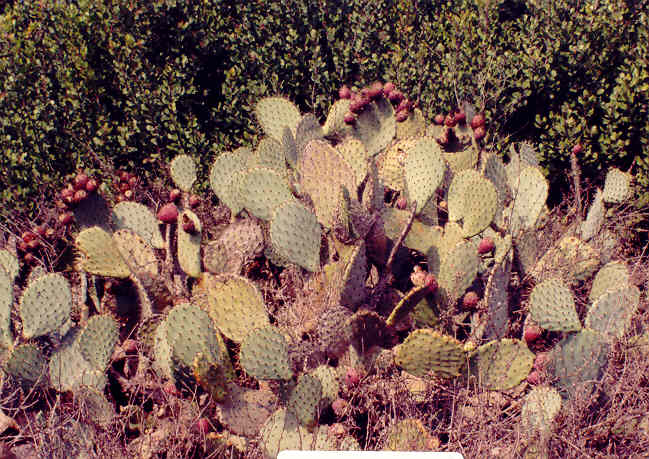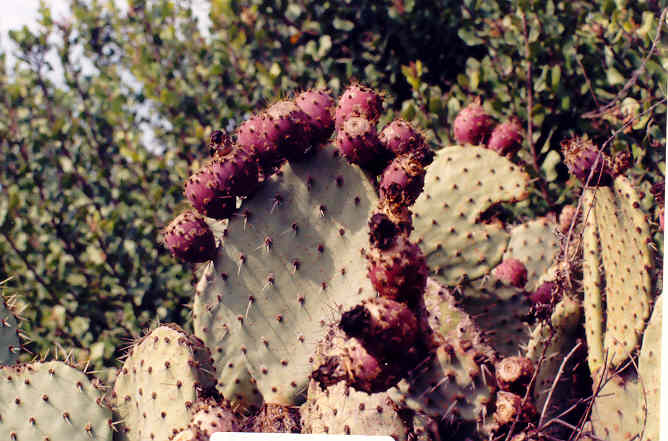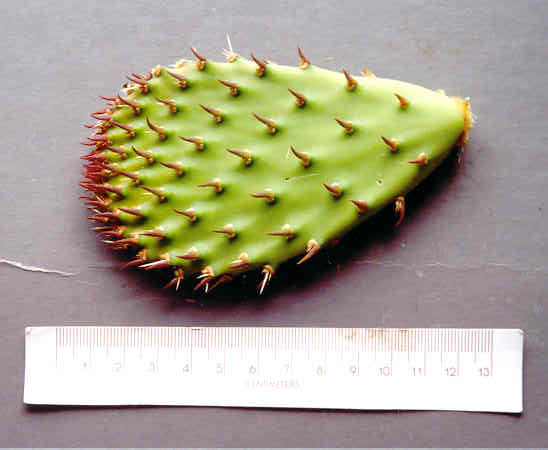
 |
Opuntia hybridCactaceae(Cactus Family)Origin unknownOpuntia |
November Photo
Plant Characteristics: Stems sprawling to erect, greater than 1 m. tall; segments flat, 16-21 cm. across, 20-24 cm long, generally obovate, blue green; spines 2-3 in 65% of the 45-65 areoles; spines in lower areoles 0-1, spines generally round, straight, white, to 15 mm. long, unequal in length, spreading on upper margins, others +/- reflexed; lvs. awl shaped, 7-8 mm. long, reddish, early caducous; fls. yellow; style pink, stigma green; filaments yellow; fr. 5 cm. long, fleshy, reddish purple, spheric with flat top, areoles +/- 35, some with short spines 5-7 mm. long.
Habitat: One of the many Opuntia species found in the upper bay and Orange County. It may be native or a hybrid with the non-native Opuntia ficus-indica, the only non-native listed in Orange County. Where did the parents of this hybrid come from, there are few other species in the area that this plant could be a hybrid of? (my comments). Blooms May-June.
Name: See other Opuntias for the meaning of the genus name.
General: To the best of my knowledge this Opuntia hybrid occurs only on the bluff above the easterly end of the wooden horse and bike path in Santa Ana Heights. I first noticed the plant a number of years ago while jogging up and down a bluff path used by the horses in the area. The color and shape of the pads is distinctive being much bluer, wider and thicker than the nearby O. littoralis plants. (my comments). My old mentor John Johnson has the following comments about the origin of this specimen: “I suspect it is a variation of Opuntia littoralis. One can say it is a hybrid, but what other species are local with which its parent could hybridize? Very possibly it may be that all of the local cacti are hybrids, and as they cross-fertilize, random and independent assortment take place involving many different sets of genetic traits that result in an enormous variety among the offspring. This idea appeals to me as the best explanation for the many variations that one observes among the wild-growing cacti.” (John Johnson). The Southern Diegueno would split the tuna lengthwise, empty out the seeds, then place the pulp upward, exposed to the sun. After a few days the dried fruit could be stored until needed. It could be eaten like a large raisin. (Campbell 156). Probably 300 species from the Straits of Magellan to s. Canada. (Munz, Flora So. Calif. 314). Hickman states there are about 200 species in the Americas. (Hickman, Ed. 452). Dawson states that the more we learn about cactus, the less certain we are of just how many species there are. (Dawson 6).
Text Ref: Dawson 15; Hickman, Ed. 452; Munz, Flora So. Calif. 314.
Photo Ref: Nov-Mar 99-00 # 1,2,3,4; April-May 01 # 21; May-June 01 # 4A.
Identity: by R. De Ruff.
First Found: January 2000.
Computer Ref: Plant Data 537.
No plant specimen.
Last edit 6/9/05.
 |
 |
November Photo May Photo